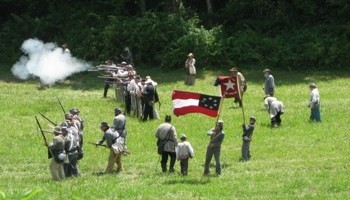Battle of Gatlinburg
Introduction
Text-to-speech Audio
Images
Photo of William J. Palmer, 15th Pennsylvania Cavalry. Date of photo unknown.

Photo of William H. Thomas

Battle of the Burg reenactment

Backstory and Context
Text-to-speech Audio
The Battle of the Burg as it was called was a small battle during the Civil War between Union and Confederate forces in Gatlinburg, Tennessee. Most citizens that lived within this area wished to remain neutral, but as the fates would have it this area would not be able to stay out of the conflict indefinitely. The battleground is in present day Gatlinburg, Tennessee, and every year a reenactment of this battle is performed for the public. During the Civil War, this area was occupied by Confederate forces and it was an area that was rich in saltpeter and the mining of this resource was of high importance to all. What made saltpeter so important was that this natural resource was used to make gunpowder and Epsom salts, which was vital to both the Union and Confederate forces. Both sides could gain if they controlled this mining area. The people who lived in the town were providing the food and other goods for the troops of Major William Thomas. His regiment included Indians, guerrillas, and, of course, white men and they had been promised by Thomas that they would not actually fight in a battle but would instead be helping to build a road to access the mines and be involved in the mining of the precious saltpeter that they depended on for their cause. Alum Cave was the location where the saltpeter was mined and it was here that Colonel William Thomas and his troops were settled in order to protect its invaluable resources. During the battle itself, the Union troops intended on gaining access to the cave for its resources and hoped that it would weaken resistance.
The total time the Confederate forces occupied Gatlinburg was about two years. The promise that was made to the local men about serving in battle had now changed and Thomas told them that they were required to fight if the need arose. Of course, this angered the men and many deserted. In December of 1863 two companies were issued with the task of getting the Confederate troops out of Gatlinburg, and this is where the battle of the Burg begins.
Union Colonial William Palmer of the 15th Pennsylvania Cavalry led 150 men from Wear’s Valley, Tennessee and Colonel C.D. Lamborn led 50 men from Sevierville, Tennessee and these two forces met in Gatlinburg where they would begin their task of ridding the city of the Confederate forces. December 20, 1863 was the morning that the Union and Confederate forces would come face to face at the block house that was built by major William Thomas on Burg Hill. After a small fight the Confederate forces realized they were outnumbered and fled across the Smoky Mountains. No casualties were reported during this battle, although a few were wounded and one Union soldier was taken captive during the altercation.
